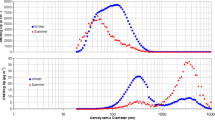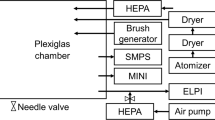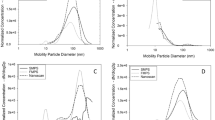Abstract
Exposure to airborne ultrafine and nanoparticles has raised increased interest over the recent years as they may cause adverse health effects. A common way to quantify exposure to airborne particles is to measure particle number size distributions through electrical mobility analysis. Four mobility particle sizers have been subject to a detailed intercomparison study, a TSI Fast Mobility Particle Sizer (FMPS), a Grimm Sequential Mobility Particle Sizer (SMPS+C), and two TSI Scanning Mobility Particle Sizers (SMPSs), equipped with two different condensation particle counters (CPC). The instruments were challenged with either NaCl or diesel soot particles. The results indicate that the sizing of all tested instrument was similar with only the FMPS size distributions consistently shifted toward smaller particle sizes. The Grimm SMPS generally measured higher concentrations and broader distributions than the TSI instruments. The two Grimm DMAs agreed well with each other; however, the TSI SMPS results showed a reproducible dependence on the flow rates. While TSI and Grimm SMPS delivered consistent results for sodium chloride (NaCl) and diesel soot, the FMPS seemed to react differently to the changing particle source than the SMPSs, which may be caused by either the different morphology or particle size dependent effects. For NaCl particles, the FMPS delivered the narrowest distributions and concentrations comparable with TSI SMPSs, whereas for diesel soot, it delivered the broadest distributions and higher concentrations than TSI SMPSs.







Similar content being viewed by others
References
Atkinson RW, Anderson HR, Sunyer J, Ayres J, Baccini M, Vonk JM, Boumghar A, Forastiere F, Forsberg B, Touloumi G, Schwartz J, Katsouyanni K (2001) Accute effects of particulate air pollution on respiratory admissions—Results from the APHEA 2 project. Am J Resp Crit Care 164:1860–1866
Cunningham E (1910) On the velocity of steady fall of spherical particles through fluid medium. Proc R Soc London Ser A 83:357–365
Dahmann D, Riediger G, Schletter J, Wiedensohler A, Carli S, Graff A, Grosser M, Hojgr M, Horn HG, Matter U, Monz C, Mosimann T, Stein H, Wehner B, Wieser U (2001) Intercomparison of mobility particle sizers (MPS). Gefahrst Reinhalt Luft 61:423–427
Dockery DW, Pope CA, Xu X, Spengler JD, Ware JH, Fay ME, Ferris BG, Speizer FE (1993) An association between air pollution and mortality in six U.S. cities. New Engl J Med 329:1753–1759
Donaldson K, Li XY, Macnee W (1998) Ultrafine (nanometer) particle mediated lung injury. J Aerosol Sci 29:553–560
Fissan H, Helsper C, Thielen HJ (1983) Determination of particle size distributions by means of an electrostatic classifier. J Aerosol Sci 14:354–357
Fuchs NA (1963) On the stationary charge distribution on aerosol particles in bipolar ionic atmosphere. Geofis Pura Appl 56:185–193
Gormley PG, Kennedy M (1949) Diffusion from a stream flowing through a cylindrical tube. Proc R Irish Acad 52A:163–169
Hämeri K, Koponen IK, Aalto PP, Kulmala M (2002) Technical note: the particle detection efficiency of the TSI-3007 condensation particle counter. J Aerosol Sci 33:1463–1469
Harris SJ, Maricq MM (2001) Signature size distributions for diesel and gasoline engine exhaust particulate matter. J Aerosol Sci 32:749–764
Heim M, Kasper G, Reischl GP, Gerhart C (2004) Performance of a new commercial electrical mobility spectrometer. Aerosol Sci Technol 38:3–14
Helsper C, Horn HG, Schneider F, Wehner B, Wiedensohler A (2008) Intercomparison of five mobility particle size spectrometers for measuring atmospheric submicrometer aerosol particles. Gefahrst Reinhalt Luft 68:475–481
Hering SV, Stolzenburg MR, Quant FR, Oberreit DR, Keady PB (2005) A laminar-flow, water-based condensation particle counter (WCPC). Aerosol Sci Technol 39:659–672
Hinds WC (1999) Aerosol technology: properties, behavior, and measurement of airborne particles. Wiley, New York
Hoppel WA (1978) Determination of the aerosol size distribution from the mobility distribution of the charged fractions of aerosols. J Aerosol Sci 9:41–54
Jeong CH, Evans GJ (2009) Inter-comparison of a fast mobility particle sizer and a scanning mobility particle sizer incorporating an ultrafine water-based condensation particle counter. Aerosol Sci Technol 43:364–373
Johnson T, Caldow R, Pöcher A, Mirme A, Kittelson D (2003) An engine exhaust particle sizer™ spectrometer for transient emission particle measurements. In: 9th Diesel Engine Emissions Reduction (DEER) Workshop 2003, Newport, RI, USA
Kim JH, Mulholland GW, Kukuck SR, Pui DYH (2005) Slip correction measurements of certified PSL nanoparticles using a nanometer differential mobility analyzer (Nano-DMA) for Knudsen number from 0.5 to 83. J Res Natl Inst Stand Technol 110:31
Kinney PD, Pui DYH, Mulholland GW, Bryner NP (1991) Use of the electrostatic classification method to size 0.1 μm SRM particles—a feasibility study. J Res Natl Inst Stand Technol 96:147–176
Knutson EO, Whitby KT (1975) Aerosol classification by electrical mobility analysis: apparatus, theory, and applications. J Aerosol Sci 6:443–451
Koch W, Pohlmann G, Schwarz K (2008) A reference number concentration generator for ultrafine aerosols based on Brownian coagulation. J Aerosol Sci 39:150–155
Kreyling WG, Semmler M, Erbe F, Mayer P, Takenaka S, Schulz H, Oberdörster G, Ziesenis A (2002) Translocation of ultrafine insoluble iridium particles from lung epithelium to extrapulmonary organs is size dependent but very low. J Toxicol Env Health 65:1513–1530
Kuhlbusch TAJ, Fissan H (2006) Particle characteristics in the reactor and pelletizing areas of carbon black production. J Occup Env Hyg 3:558–567
Kuhlbusch TAJ, Neumann S, Fissan H (2004) Number size distribution, mass concentration, and particle composition of PM1, PM2.5 and PM10 in bagging areas of carbon black production. J Occup Env Hyg 1:660–671
Kuhlbusch TAJ, Fissan H, Asbach C (2009) Nanotechnologies and environmental risks. In: Linkov I, Steevens J (eds) Nanomaterials: risks and benefits. Springer, Berlin, pp 233–243
Lall AA, Friedlander SK (2006) On-line measurement of ultrafine aggregate surface area and volume distributions by electrical mobility analysis: I. Theoretical analysis. J Aerosol Sci 37:260
Lall AA, Seipenbusch M, Friedlander SK (2006) On-line measurement of ultrafine aggregate surface area and volume distributions by electrical mobility analysis: II. Comparison of measurements and theory. J Aerosol Sci 37:272
Matson U, Ekberg LE, Afshari A (2004) Measurement of ultrafine particles: a comparison of two handheld condensation particle counters. Aerosol Sci Technol 38:487–495
Mirme A, Tamm E (1991) Comparison of sequential and parallel measurement principles in aerosol spectrometry. J Aerosol Sci 22S(1):S331–S334
Mirme A, Tamm E (1993) Electric aerosol spectrometer. Calibration and error account. J Aerosol Sci 24S(1):S211–S212
Mulholland GW, Donnelly MK, Hagwood CR, Kukuck SR, Hackley VA, Pui DYH (2006) Measurement of 100 nm and 60 nm particle standards by differential mobility analysis. J Res Natl Inst Stand Technol 111:257–312
Oberdörster G (2000) Toxicology of ultrafine particles: in vivo studies. Philos Trans R Soc Lond A 358:2719–2740
Oberdörster G, Sharp Z, Atudorei V, Elder A, Gelein R, Kreyling W, Cox C (2004) Translocation of inhaled ultrafine particles to the brain. Inhal Toxicol 16:437–445
Oh H, Park H, Kim S (2004) Effect of particle shape on the unipolar diffusion charging of nonspherical particles. Aerosol Sci Technol 38:1045–1053
Park K, Cao F, Kittelson DB, McMurry PH (2003) Relationship between particle mass and mobility for diesel exhaust particles. Environ Sci Technol 37:577–583
Peters A, Wichmann HE, Tuch T, Heinrich J, Heyder J (1997) Respiratory effects are associated with the number of ultrafine particles. Am J Resp Crit Care 155:1376–1383
Pui YH, Liu BYH (1974) A submicron aerosol standard and the primary absolute calibration of the condensation nuclei counter. J Colloid Interface Sci 47:155–171
Reineking A, Porstendörfer J (1986) Measurement of particle loss functions in a differential mobility analyzer (TSI, Model 3071) for different flow rates. Aerosol Sci Technol 27:483–486
Soderholm SC (1979) Analysis of diffusion battery data. J Aerosol Sci 10:163–175
Tammet H, Mirme A, Tamm E (1998) Electrical aerosol spectrometer of Tartu University. J Aerosol Sci 29S(1):S427–S428
Virtanen AKK, Ristimki JM, Vaaraslahti KM, Keskinen J (2004) Effect of engine load on diesel soot particles. Environ Sci Technol 38:2551–2556
Wang SC, Flagan RC (1990) Scanning electrical mobility spectrometer. Aerosol Sci Technol 13:230–240
Wang J, Flagan RC, Seinfeld JH (2002) Diffusional losses in particle sampling systems containing bends and elbows. J Aerosol Sci 33:843–857
Wen HY, Reischl GP, Kasper G (1984) Bipolar diffusion charging of fibrous aerosol particles—II. Charge and electrical mobility measurements on linear chain aggregates. J Aerosol Sci 15:103–122
Wiedensohler A (1988) An approximation of the bipolar charge distribution for particles in the submicron size range. J Aerosol Sci 19:387–389
Winklmayr W, Reischl GP, Lindner AO, Berner A (1991) A new electromobility spectrometer for the measurement of aerosol size distributions in the size range from 1 to 1000 nm. J Aerosol Sci 22:289–296
Acknowledgment
This work was supported by the German Federal Ministry of Education and Research (BMBF) as part of the NanoCare project.
Author information
Authors and Affiliations
Corresponding author
Rights and permissions
About this article
Cite this article
Asbach, C., Kaminski, H., Fissan, H. et al. Comparison of four mobility particle sizers with different time resolution for stationary exposure measurements. J Nanopart Res 11, 1593–1609 (2009). https://doi.org/10.1007/s11051-009-9679-x
Received:
Accepted:
Published:
Issue Date:
DOI: https://doi.org/10.1007/s11051-009-9679-x




